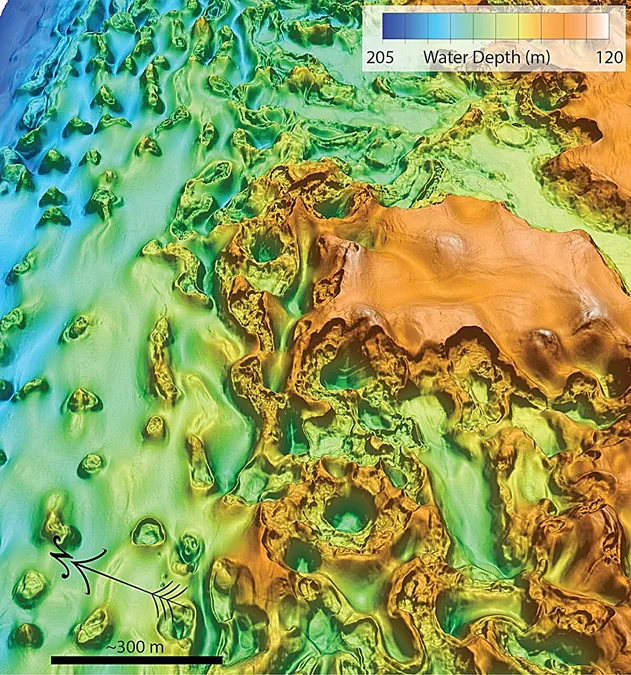
Surprising Discovery: Researchers Unravel the Secrets of the Arctic Seafloor Transformation
2024-10-08
Author: Nur
Surprising Discovery: Researchers Unravel the Secrets of the Arctic Seafloor Transformation
In a fascinating breakthrough, researchers from the Monterey Bay Aquarium Research Institute (MBARI) have uncovered large underwater ice formations at the edge of the Canadian Beaufort Sea—an area once thought to be largely impenetrable due to its remote Arctic conditions. This groundbreaking study, conducted with international partners including the Korea Polar Research Institute and the Geological Survey of Canada, reveals an unexpected mechanism for the ongoing formation of submarine permafrost ice that challenges previously held assumptions.
Previous investigations by MBARI unveiled gigantic craters on the seafloor, attributed to the thawing of ancient submerged permafrost. The researchers aimed to explore these craters and stumbled upon newly exposed layers of ice, which differ significantly from the ancient permafrost formed during the last ice age. Instead, these layers are being formed under current climate conditions, as melting ancient permafrost generates brackish groundwater that rises and refreezes near the seafloor where temperatures plummet to -1.4 °C (29.5 °F).
The topography of this peculiar Arctic seafloor tells a tale of both ancient thawing and modern disfiguration, illustrating a dynamic interplay between these processes. After the last ice age, rising sea levels submerged ancient permafrost, which is now gradually warming and thawing due to internal geological heat. Interestingly, the melting of this underwater permafrost is linked to natural climatic variations rather than direct consequences of human-induced climate change.
The interplay between salinity and temperature drives a remarkable process: as groundwater migrates upward to the frigid seafloor, it freezes and gives birth to ridges and unique mounds. These formations create a rugged landscape with substantial sinkholes where seawater seeps in, melting ice layers and revealing dramatic topographical changes—an ever-evolving underwater world.
Charlie Paull, a geologist at MBARI, notes the significance of these findings: "Our research indicates that permafrost ice is not just an artifact of the past; it is actively forming and decomposing throughout a vast area, shaping a dynamic seafloor marked by massive sinkholes and ice-laden sediment." This knowledge carries substantial implications for policymakers involved in planning underwater infrastructure in the Arctic, especially as climate patterns continue reshaping the region.
Since its inception in 2003, MBARI's collaboration has explored this previously inaccessible location, revealing its rugged terrain and diverse geological features, all brought to light by the retreating sea ice attributed to global warming. A series of mapping initiatives since 2010 have cataloged over 65 newly-formed craters, with the largest being comparable in size to a city block of six-story buildings.
In 2022, researchers returned aboard the Korean icebreaker Araon, using advanced technology to map and visually survey these distinctive craters. Their efforts, enhanced by the use of MBARI's MiniROV—a remotely operated vehicle equipped with cameras and sampling tools—provided invaluable insights into the shrouded mysteries of this Arctic underworld. Analysis confirmed that the ice formations originated from ascending brackish groundwater, resulting from the thawing permafrost.
The revelations from this latest study redefine our understanding of underwater permafrost, proving that it is much more than a remnant of ice age history. Instead, researchers are now aware that active processes are taking place beneath the icy surfaces, suggesting that similar phenomena could exist in other polar regions with sub-zero bottom-water temperatures.
As our climate continues to change, the lessons gleaned from these Arctic explorations are not just scientific pursuits; they illuminate the urgent need for adaptive strategies in response to our planet's evolving landscape. The ocean's depths are now revealing secrets that could reshape our approach to future environmental challenges.



 Brasil (PT)
Brasil (PT)
 Canada (EN)
Canada (EN)
 Chile (ES)
Chile (ES)
 España (ES)
España (ES)
 France (FR)
France (FR)
 Hong Kong (EN)
Hong Kong (EN)
 Italia (IT)
Italia (IT)
 日本 (JA)
日本 (JA)
 Magyarország (HU)
Magyarország (HU)
 Norge (NO)
Norge (NO)
 Polska (PL)
Polska (PL)
 Schweiz (DE)
Schweiz (DE)
 Singapore (EN)
Singapore (EN)
 Sverige (SV)
Sverige (SV)
 Suomi (FI)
Suomi (FI)
 Türkiye (TR)
Türkiye (TR)